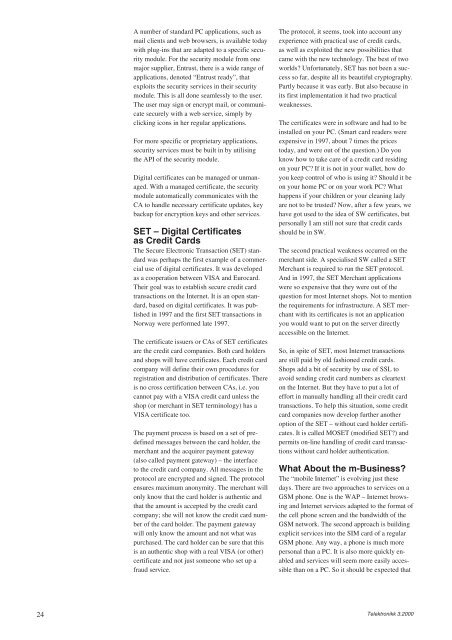Security - Telenor
Security - Telenor
Security - Telenor
You also want an ePaper? Increase the reach of your titles
YUMPU automatically turns print PDFs into web optimized ePapers that Google loves.
24<br />
A number of standard PC applications, such as<br />
mail clients and web browsers, is available today<br />
with plug-ins that are adapted to a specific security<br />
module. For the security module from one<br />
major supplier, Entrust, there is a wide range of<br />
applications, denoted “Entrust ready”, that<br />
exploits the security services in their security<br />
module. This is all done seamlessly to the user.<br />
The user may sign or encrypt mail, or communicate<br />
securely with a web service, simply by<br />
clicking icons in her regular applications.<br />
For more specific or proprietary applications,<br />
security services must be built in by utilising<br />
the API of the security module.<br />
Digital certificates can be managed or unmanaged.<br />
With a managed certificate, the security<br />
module automatically communicates with the<br />
CA to handle necessary certificate updates, key<br />
backup for encryption keys and other services.<br />
SET – Digital Certificates<br />
as Credit Cards<br />
The Secure Electronic Transaction (SET) standard<br />
was perhaps the first example of a commercial<br />
use of digital certificates. It was developed<br />
as a cooperation between VISA and Eurocard.<br />
Their goal was to establish secure credit card<br />
transactions on the Internet. It is an open standard,<br />
based on digital certificates. It was published<br />
in 1997 and the first SET transactions in<br />
Norway were performed late 1997.<br />
The certificate issuers or CAs of SET certificates<br />
are the credit card companies. Both card holders<br />
and shops will have certificates. Each credit card<br />
company will define their own procedures for<br />
registration and distribution of certificates. There<br />
is no cross certification between CAs, i.e. you<br />
cannot pay with a VISA credit card unless the<br />
shop (or merchant in SET terminology) has a<br />
VISA certificate too.<br />
The payment process is based on a set of predefined<br />
messages between the card holder, the<br />
merchant and the acquirer payment gateway<br />
(also called payment gateway) – the interface<br />
to the credit card company. All messages in the<br />
protocol are encrypted and signed. The protocol<br />
ensures maximum anonymity. The merchant will<br />
only know that the card holder is authentic and<br />
that the amount is accepted by the credit card<br />
company; she will not know the credit card number<br />
of the card holder. The payment gateway<br />
will only know the amount and not what was<br />
purchased. The card holder can be sure that this<br />
is an authentic shop with a real VISA (or other)<br />
certificate and not just someone who set up a<br />
fraud service.<br />
The protocol, it seems, took into account any<br />
experience with practical use of credit cards,<br />
as well as exploited the new possibilities that<br />
came with the new technology. The best of two<br />
worlds? Unfortunately, SET has not been a success<br />
so far, despite all its beautiful cryptography.<br />
Partly because it was early. But also because in<br />
its first implementation it had two practical<br />
weaknesses.<br />
The certificates were in software and had to be<br />
installed on your PC. (Smart card readers were<br />
expensive in 1997, about 7 times the prices<br />
today, and were out of the question.) Do you<br />
know how to take care of a credit card residing<br />
on your PC? If it is not in your wallet, how do<br />
you keep control of who is using it? Should it be<br />
on your home PC or on your work PC? What<br />
happens if your children or your cleaning lady<br />
are not to be trusted? Now, after a few years, we<br />
have got used to the idea of SW certificates, but<br />
personally I am still not sure that credit cards<br />
should be in SW.<br />
The second practical weakness occurred on the<br />
merchant side. A specialised SW called a SET<br />
Merchant is required to run the SET protocol.<br />
And in 1997, the SET Merchant applications<br />
were so expensive that they were out of the<br />
question for most Internet shops. Not to mention<br />
the requirements for infrastructure. A SET merchant<br />
with its certificates is not an application<br />
you would want to put on the server directly<br />
accessible on the Internet.<br />
So, in spite of SET, most Internet transactions<br />
are still paid by old fashioned credit cards.<br />
Shops add a bit of security by use of SSL to<br />
avoid sending credit card numbers as cleartext<br />
on the Internet. But they have to put a lot of<br />
effort in manually handling all their credit card<br />
transactions. To help this situation, some credit<br />
card companies now develop further another<br />
option of the SET – without card holder certificates.<br />
It is called MOSET (modified SET?) and<br />
permits on-line handling of credit card transactions<br />
without card holder authentication.<br />
What About the m-Business?<br />
The “mobile Internet” is evolving just these<br />
days. There are two approaches to services on a<br />
GSM phone. One is the WAP – Internet browsing<br />
and Internet services adapted to the format of<br />
the cell phone screen and the bandwidth of the<br />
GSM network. The second approach is building<br />
explicit services into the SIM card of a regular<br />
GSM phone. Any way, a phone is much more<br />
personal than a PC. It is also more quickly enabled<br />
and services will seem more easily accessible<br />
than on a PC. So it should be expected that<br />
Telektronikk 3.2000

















